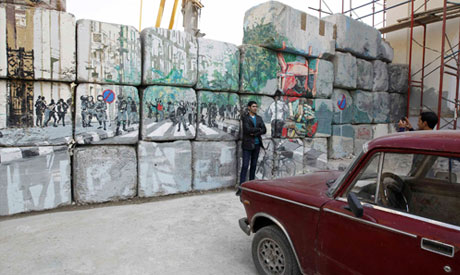
An Egyptian man takes a photo in front of the "No Walls Street" graffiti, a reproduction of the streets behind them and the concrete blocks at El Shikh Rehan street which leads to the Interior Ministry, where clashes between protesters and security force took place during the revolution in downtown Cairo (Photo: Reuters)
A few weeks ago in October, while I was undertaking my ritual stroll through Cairo's Mohamed Mohmoud Street in search of the ever-changing graffiti, I witnessed a conglomeration of young female students (between 14 and 17 years old) from the Lycee school located on the other side of the army-built wall on Youssef El-Guindy Street.
The female students were vehemently protesting the insurmountable wall near Tahrir Square, which was built by the security forces during December clashes between military police and protesters, for two main reasons.
Firstly, some weeks earlier, local residents had managed to tear down a few concrete blocks which allowed the pedestrians to walk on a ramp and cross through the gap to the other side of the street.
The few blocks that were removed made life easier for the female students. They could simply reach their school from Mohammed Mahmoud Street and thus avoid a twenty minute detour via Mansour and Noubar Streets three, or four block away.
The second reason the girls were complaining was because they were constantly being sexually harassed and physically grabbed by the local security soldiers. They were fed up of the daily humiliation.
What fascinated me was the fact that the female students refused to negotiate with the school's principal unless he met them on the street. Their strategy was to make their protest a public issue.
I witnessed the first hour of heated confrontations with the school head.
The girls were screaming at him, expressing their anger about the systematic sexual harassment which each of them had been subjected to in front of the Ministry of Interior, a place they wanted to avoid at any price.
The director was hopelessly trying to convince them to go to school but failed to do so.
When I visited the area later on, to my astonishment, I found out that the wall had been displaced and was re-erected some 20 or 30 metres away in the direction of Sheikh Rehan Street.
This done, it became much easier to reach the school’s main entrance from Mohammed Mahmoud Street. It seems then that the girls’ demands had been met.
However, the wall, even if it has been moved, still remains solid, alive and kicking.
Imagine the amount of work and energy it took to dismantle a concrete wall and rebuild it a few metres away on the same street? How long will this ordeal of barriers and walls continue?
Pedestrians are perfecting their acrobatic skills on a daily basis to surmount these barriers. Yet the fact that the public struggles through never-ending detours around the segregated areas like the Ministry of Interior, does not seem to bother the officials.
The coming weeks will see the anniversary of the bloody events on Mohamed Mahmoud Street which led to the building of these walls. Have Cairenes become so used to the barricades that they have been incorporated in the landscape of everyday life in downtown?
I have great doubts that this is the case.
If the shortest way remains a straight line, then it seems the powers-that-be use detours as a long-term strategy for exhaustio, or perhaps they are sculpting a dominant state of mind that purposely makes life harder for the majority of pedestrians more so than car drivers. But who really cares about pedestrians?
Short link: